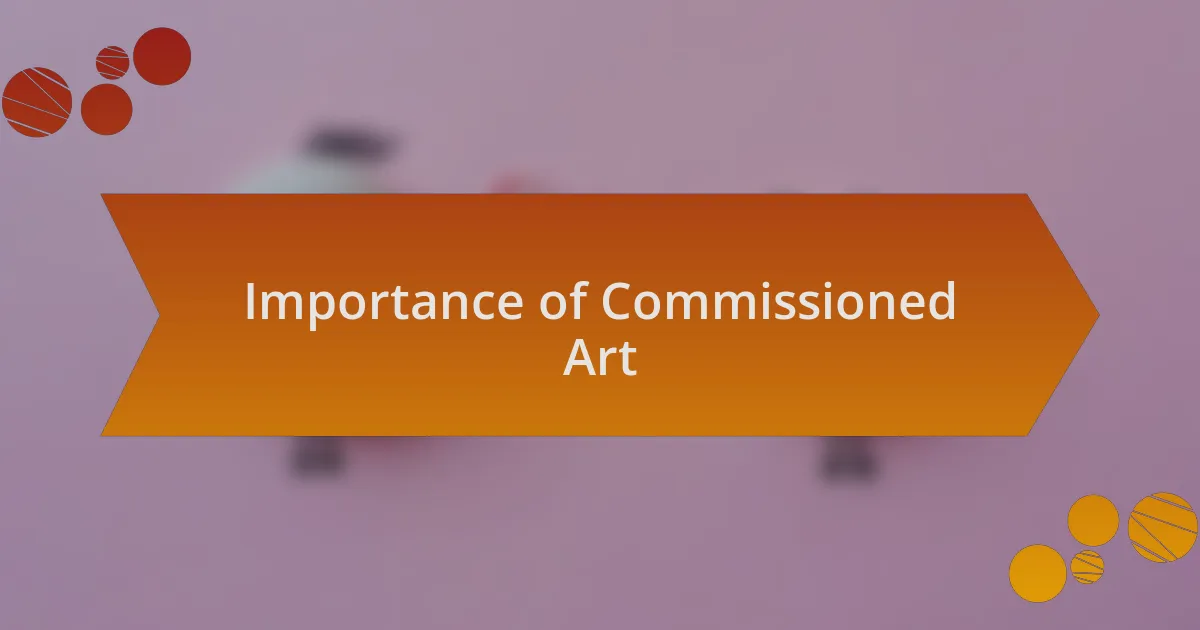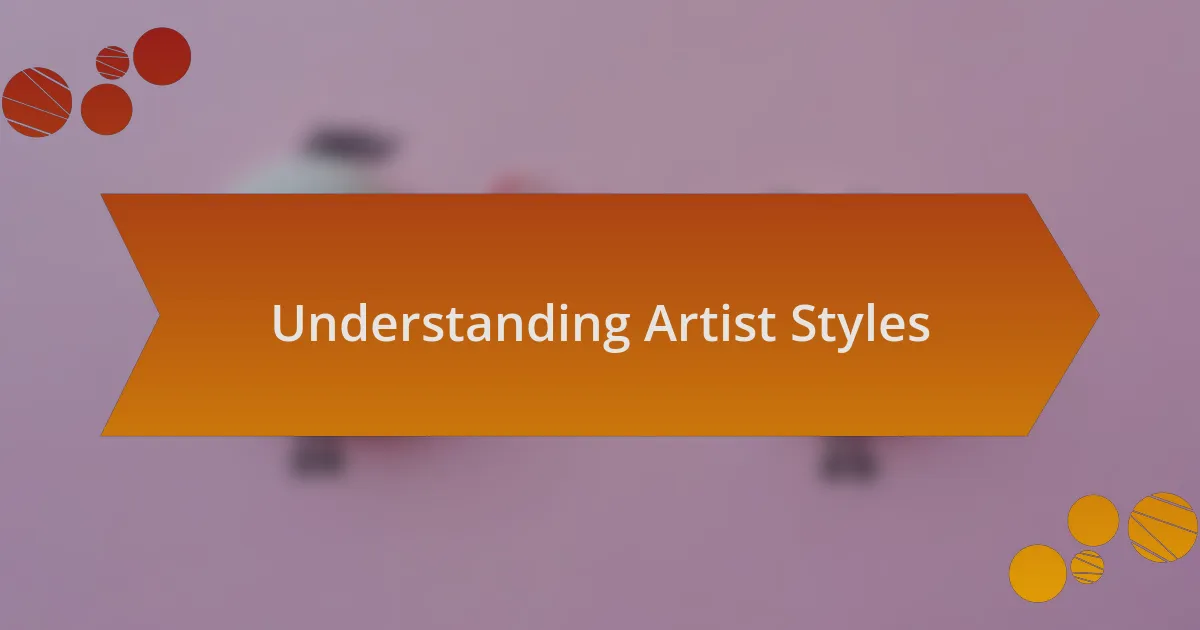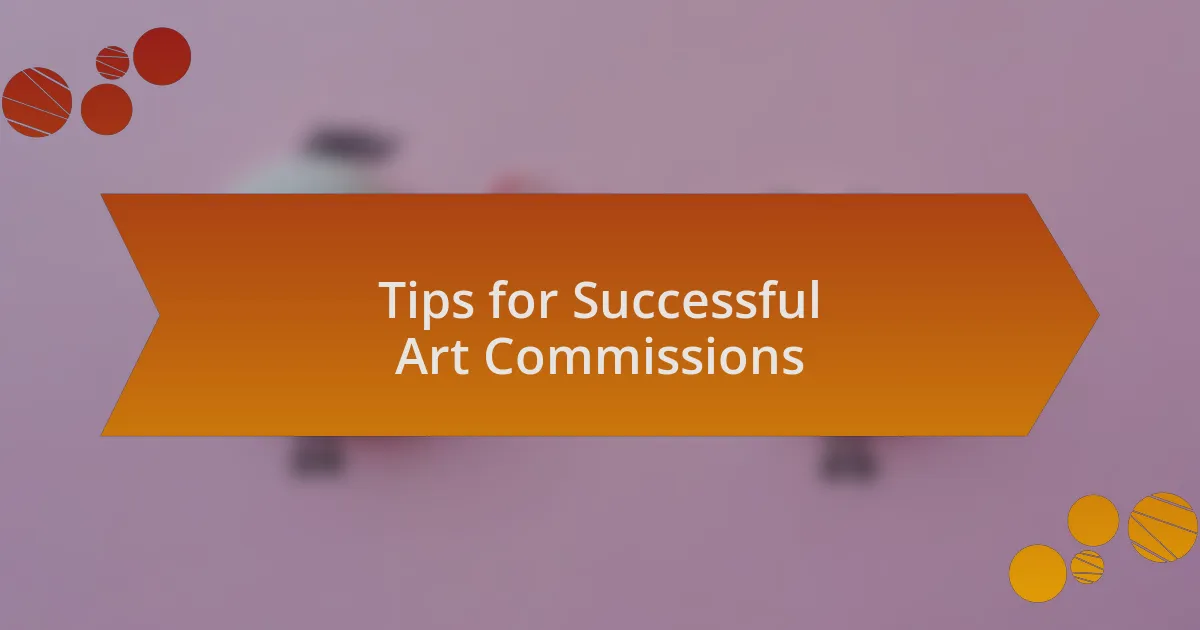Key takeaways:
- Commissioned artworks reflect personal narratives, transforming spaces into meaningful expressions of identity.
- Effective communication between the artist and client is essential for a successful collaboration, enhancing both the artwork and the experience.
- Understanding an artist’s style and setting a clear budget can significantly impact the commissioning process and final outcome.
- Flexibility and adaptability during the creative process can lead to unexpected and beautiful transformations in the artwork.

Overview of Commissioned Artworks
Commissioned artworks are unique pieces created specifically for a client, blending their personal vision with the artist’s creativity. I remember the thrill I felt when I received my first commission; it was more than a project—it was an intimate collaboration. Isn’t it fascinating how art can become a reflection of one’s identity, transforming a mere space into a storyteller’s canvas?
These artworks often serve various purposes, from commemorating milestones to enhancing spaces with deep personal meaning. In my experience, the emotional connection established during the commissioning process adds layers to the final piece, turning it into something truly special. Have you ever considered how a well-placed piece of art can evoke specific feelings that resonate with visitors?
Moreover, the commissioning process involves clear communication and a mutual understanding between the artist and the client. It’s a dance of ideas and expectations, and every conversation contributes to the final result. I’ve found that the best outcomes arise when clients share not just their ideas but their stories—what drives them, what moves them—ensuring the artwork is not only a visual delight but also a heartfelt expression of their journey.

Importance of Commissioned Art
Creating commissioned art is significant because it allows individuals to express their personal narratives in ways that standard art cannot. I remember a client who wanted a piece dedicated to their late grandmother, which transformed the art into a tribute rather than just decoration. How powerful is it to see a story painted right on your wall, an everlasting remembrance in colors and forms?
Commissioned artworks foster a unique bond between the creator and the client, allowing for the merging of distinct visions. I once worked with a couple who were redecorating their home; they felt strongly about including symbols of their multicultural backgrounds. This collaboration didn’t just result in a beautiful piece, but a tapestry of their story, weaving together their histories. Have you ever thought about how art can bridge cultures and experiences?
On a practical level, commissioned art holds value as it contributes to the artist’s growth and the evolution of the art itself. Every request challenges me to explore new techniques and perspectives, expanding my creative boundaries. In my experience, this not only enriches my portfolio but also nurtures a vibrant community of supporters who appreciate the creativity behind commissioned pieces. Isn’t it inspiring to think that each commission has the potential to push an artist toward uncharted territories?

Steps to Commissioning Art
When you decide to commission art, the first step is to clearly define your vision. I often encourage clients to create a mood board—gathering images or colors that resonate with them. This process can be enlightening; it helps to articulate what emotions you want the artwork to evoke. Have you ever noticed how certain colors can bring back vivid memories?
Next comes the discussion with the artist. This is where I believe the heart of the collaboration lies. Sharing your inspirations and ideas opens a dialogue that not only gives the artist a sense of your style but also establishes a foundation of trust. I recall one memorable session where a client hesitated to share a personal anecdote about their childhood—once they did, it sparked ideas that brought a level of depth to the artwork they never anticipated. How often do we underestimate the power of our stories?
Finally, once you’ve agreed on the concept, budget, and timeline, don’t shy away from giving feedback during the creative process. I remember working on a piece where the initial draft didn’t quite hit the mark for a client. Instead of feeling discouraged, I found it invigorating to adjust my approach based on their input. This collaborative spirit doesn’t just enhance the final result; it turns the entire experience into a meaningful journey. Have you considered how powerful it can feel to be so intricately involved in the creation of something uniquely yours?

Understanding Artist Styles
Understanding an artist’s style is pivotal to creating a successful commissioned artwork. I often find that styles can reflect not just technical skills but also the artist’s unique worldview. For instance, when I first encountered abstract expressionism, I was captivated by how it conveyed emotions without depicting recognizable subjects. Have you ever felt more connected to a piece that seems to resonate with your personal experiences?
As I delve into different artistic techniques, I’ve learned that an artist’s approach often influences the mood of the artwork. A painter who uses bold brush strokes may evoke a sense of energy, while one who prefers soft pastels might instill a feeling of calm. I recall a project where a client’s preference for impressionism opened doors to a discussion about light and movement, ultimately guiding the work’s direction. Isn’t it fascinating how the technical aspects of an artist’s style can tap into emotional responses we didn’t even know we had?
Moreover, understanding styles also means appreciating the narratives behind them. Every stroke and choice of color tells a story about the artist’s experiences or cultural background. I remember exploring a series of works inspired by a client’s travels. By extracting elements from their journeys, we transformed the piece into a visual memoir. Have you thought about how deeply personal narratives can be woven into commissioned art?

Setting a Budget for Art
Setting a budget for art can often feel overwhelming, but it’s crucial for both the artist and the client. I remember the first time I worked with a client who had a clear budget in mind; it opened up a productive conversation about what was possible. Have you ever found that establishing financial boundaries can actually enhance creativity?
When determining your budget, consider not just the price of the artwork itself, but also the potential costs for materials, shipping, and framing. I encountered a situation where a client underestimated these additional expenses, leading to a last-minute scramble. It taught me how important it is to be transparent about all associated costs upfront. What have you learned about the hidden costs of commissioning art?
Finally, think about the value of investing in art versus the monetary aspect. For me, the emotional connection I’ve built with collectors has always justified the expense. One collector expressed that the artwork became a cherished part of their home, far beyond its price tag. Isn’t it remarkable how meaningful art can transform a space and enrich our lives?

My Personal Commissioning Experience
When I first stepped into the world of commissioned artworks, I was both excited and nervous about how to navigate the process. I recall a particular project where a client requested a portrait of their beloved dog. As I painted, I drew upon my own memories of pets, channeling that emotional connection into my work. Have you ever felt your past experiences deeply influence your creative output?
One memorable commission involved a couple who wanted a piece to celebrate their anniversary. They shared stories about their journey together, which inspired me to incorporate elements that reflected their life—like small details from their favorite vacation spots. It made me realize how profoundly personal and collaborative commissioning art can be. Isn’t it fascinating how art can serve as a storytelling medium, connecting different narratives into one visual piece?
I’ve also learned that flexibility plays a crucial role in the commissioning process. There was a time when a client changed their mind about the color palette halfway through. Instead of pushing back, I embraced the change, which ultimately resulted in a more vibrant and suitable artwork. This experience taught me that sometimes, going with the flow can lead to unexpected, beautiful outcomes. How have your moments of adaptability shaped your creative projects?

Tips for Successful Art Commissions
When embarking on a commissioned artwork, one crucial tip is to maintain open communication with your client. In a past project, I made it a point to schedule multiple check-ins throughout the creative process. This not only helped manage expectations but also allowed me to gain deeper insights into their vision. I find that asking specific questions—like what colors or emotions resonate with them—can spark inspiration. Have you ever realized how a simple conversation can unlock new ideas?
Another element to consider is setting clear boundaries regarding revisions. In my early commissions, I found myself overwhelmed by constant requests for changes. After a few exhausting experiences, I learned to establish a reasonable number of revision rounds at the outset. When clients understand these limits, it fosters a more efficient workflow and prevents misunderstandings. It makes me think—how can we create a balance between client satisfaction and artistic integrity?
Lastly, don’t underestimate the power of a contract or agreement detailing the terms. I once had a delightful project that turned sour due to a lack of clarity on payment timelines. Since then, I’ve always prioritized drafting a simple agreement that outlines deadlines, costs, and expectations. This not only protects both parties but also cultivates trust and professionalism. How much more peace of mind do you think a well-drafted agreement could bring to a creative partnership?